Sloviansk
Sloviansk[lower-alpha 1] is a city in Donetsk Oblast, northern part of the Donbas region of eastern Ukraine, in the valley of the Kazennyi Torets River, a right tributary of the Donets. The city was known as Tor until 1784.[6] Sloviansk served as the administrative center of the Sloviansk Raion (district) until its abolition on 18 July 2020, though it did not actually belong to the raion itself.
Sloviansk
Слов'янськ | |
|---|---|
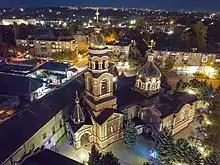 %252C_46.jpg.webp)  .jpg.webp) | |
 Flag  Coat of arms | |
 Sloviansk  Sloviansk | |
| Coordinates: 48°51′12″N 37°37′30″E | |
| Country | |
| Oblast | |
| Raion | |
| Hromada | Sloviansk urban hromada |
| Founded | 1645 |
| City status | 1784 |
| Government | |
| • Mayor | Vadym Liakh[1] (Opposition Bloc[1]) |
| Area | |
| • Total | 58.9 km2 (22.7 sq mi) |
| Elevation | 74 m (243 ft) |
| Population (1 January 2022)[2] | |
| • Total | 105,141 |
| • Density | 1,800/km2 (4,600/sq mi) |
| In June 2022, the population was estimated less than 24,000.[3] | |
| Postal code | 84100—84129 |
| Area code | +380-6262 |
| Climate | Warm summer subtype |
| KATOTTH | UA14120210010032554 |
| Website | http://www.slavrada.gov.ua/ |
The 2001 population of Sloviansk was 141,066, largely due to the war in Donbas, by early 2022 this was down 105,141 (2022 estimate),[7]. Following the 2022 Russian invasion of Ukraine, the city's population fell markedly, to around 24,000 by July 2022, due to shelling, and ongoing war, according to Ukrainian authorities. As of October 2023, this is the final time the city's population has been estimated. [8]
Sloviansk was one of the focal points in the early stages of the war in Donbass, in 2014, as it was one of the first cities to be seized and controlled by Russian-backed separatists, in mid-April of 2014.[9][10] Ukrainian forces then retook control of the city in July 2014, and since then, Sloviansk has been under Ukrainian control. As of October 2023, Sloviansk is an active threatre of conflict following the 2022 Russian invasion of Ukraine.[11]
History
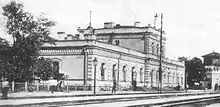
The history of Sloviansk dates back to 1645 when Russian Tsar Alexei Romanov founded a border fortress named Tor[12] against the Crimean attacks and slave raids on the southern suburbs of modern Ukraine and Russia.[13] In 1664, a first salt plant for the extraction of salt was built, and workers settled in the area.[14] In 1676, a fortress named Tor was built at the confluence of the Kazenyy Torets and Sukhyy Torets River, where they form the Torets River, a tributary of Donets River.[15] Shortly thereafter, the town of Tor grew up next to the fortress.[13]
As several salt lakes were located close by, the town became a producer of salt. During the sixteenth century, salt production was the principal local industry. Salt production stopped from 1782 to 1819 by decree of the Governor-General. [16] In 1784, the city was renamed Sloviansk. It became a part of the Kharkov Governorate of the Russian Empire in 1797. A resort was established on the shores of Lake Ropne in 1832. Salt production would remain important to the city, although it would decline through the 20th century.
In April 1918, troops loyal to the Ukrainian People's Republic briefly took control of Sloviansk.[17] Sloviansk was then, along with the rest of Ukraine, incorporated into the Ukrainian Soviet Socialist Republic.
The city was occupied by the Nazi Germans on 28 October 1941. In December 1941, the SS Einsatzkommando 4b executed more than a thousand Jews who lived in Sloviansk.[18] The Red Army temporarily expelled the Nazi occupiers on 17 February 1943. Germans retook it on 1 March 1943. The Red Army finally liberated Sloviansk on 6 September 1943.
Sloviansk would remain as part of the Ukrainian Soviet Socialist Republic until its dissolution in 1991, and from then has been part of Ukraine
2014 War in Donbas
The 2014 Ukrainian revolution passed Sloviansk by, with no large-scale gatherings or events in the city, and polls showing people in the east of Ukraine to be largely opposed to the Maidan movement in Kyiv. However, Sloviansk would quickly become the epicentre of events following the fallout of the revolution.
On 12 April 2014, in the crisis and chaos which gripped the country following the revolution's installing of the First Yatsenyuk government, a reported 55 armed men, led by Russian military veteran Igor Girkin, known as 'Igor Strelkov' stormed Sloviansk, quickly capturing the executive committee building, the police department, and the SBU office of the city.[19][20][21] Ukrainian Interior Minister Arsen Avakov described the gunmen as "terrorists" and vowed to use the Ukrainian special forces to retake the buildings.[22][23] On 13 April 2014, there were reports of fighting between the gunmen and Ukrainian troops, with casualties reported on both sides.[24][25] The BBC's David Stern described the pro-Russian forces as carrying Russian weapons and resembling the soldiers that took over Crimean installations at the start of the 2014 Crimean crisis.[24][26]
Elected mayor of Sloviansk Nelya Shtepa gave contradictory statements on her support for the pro-Russia side, and was then taken captive by the pro-Russia side. Shtepa would be one of several high-profile detainments during separatist control of Sloviansk. [27] On April 14 the pro-Russia side installed their own 'people's mayor' Vyacheslav Ponomarev, to deal with civilian matters, and press, while Strelkov / Girkin took charge of military matters. [28] Throughout April, and May, Ponomarev would hold near daily press conferences in the city's admininstrative building. [29]
On May 9, Victory Day, there was a parade, and large gathering of people in the central Square of Sloviansk. Nelya Shtepa appeared, the first time she had been seen in public since mid-April, and gave a pro-Russian speech on stage, urging people to vote in the referendum scheduled for May 11th. Recently freed separatist leader Pavel Gubarev also appeared on stage. [30] Referendums went ahead across Donbas on May 11, including Sloviansk, with the pro-Russia side reporting a turnout of near 75%, with over 90% vosting for self rule as part of the Donetsk/Luhansk People's Republics. However, the referendums were not monitored, or endorsed, by any international observers, or organisations, and their results almost universally unrecognised in the west. Russia issued a statement saying they 'respected' the results of the referendums, but stopped short of recognising. [31] [32]
Fighting intensified throughout May, as Ukrainian forces escalated their 'ATO' (Anti-Terror Operation) to retake the city, with a Ukrainian military helicopter shot down at the start of the month, and multiple casualties reported in fighting on both sides.[33] May would also see escalating civilian casualties in Sloviansk, as Ukrainian forces began their assault on the city. On May 5, 30-year-old Irina Boevets was killed by a stray Ukrainian bullet, as she stepped out on her balcony. The Guardian at the time reported these civilian deaths as "fuelling pro-Russian sentiment".[34] Fighting between sides would wage on May, with increasing intensity. A follow-up referendum to the referendum on May 11 had been planned for May 18th, giving voters the option of joining Russia, however this was abandoned due to the escalation of fighting. On 29 May 2014, a Ukrainian helicopter carrying fourteen Ukrainian special service soldiers, including General Serhiy Kulchytskiy – the head of combat and special training for Ukraine's National Guard, crashed after being shot down by militants near Sloviansk. Ukraine's outgoing President Olexander Turchynov described the downing as a "terrorist attack," and blamed pro-Russian militants.[35]
As June went on, it became clear that the pro-Russia side were losing the battle for Sloviansk. The pro-Russia side had a number of problems, including infighting, with emnity between 'people's mayor' Ponomarev, and Strelkov/Girkin, resulting in Strelkov/Girkin having Ponomarev arrested, and dismissed from his duties, on June 12. [28] Ukrainian forces further stepped up their shelling of Sloviansk in June. [36] Sloviansk was ultimately held by Russian-backed separatists for nearly three months, from mid-April until 5 July 2014, during which time fighting between the separatists and the Ukrainian army escalated, along with shelling of civilian areas of the city, with both military and civilian casualties.[37] In late June, the Ukrainian army started advancing on Sloviansk, and under heavy pressure, the Russian-backed separatists retreated from Sloviansk in early July. Initially they had planned to go to nearby Kramatorsk, however when it became clear that the Ukrainian army would also take Kramatorsk, which they duly did, most headed to Donetsk, which would then become their stronghold.[38]
Sloviansk was one of several territories taken by Ukrainian forces at this time, including the nearby cities of Kramatorsk, and Kostiantynivka.[39]
2014 to 2022
Since its recapture in July 2014, Sloviansk has remained in Ukrainian control. In 2015, as part of the process of Decommunization, the fate of Sloviansk's statue of Lenin, in the city's central square, became a topic of heated debate at council meetings. Large factions from Ukrainian ultra-national groups Svoboda and the Right Sector attended these meetings, in support of the removal / destruction of the statue. There were also locals in favour of keeping the statue, with a petition of 4,500 signatures supporting the Lenin statue remaining. No consensus had been reached, when in the early hours of June 3, Right Sector militants tore the statue down.[40]
Also in 2015, a plaque to the memory of Volodymyr Rybak, a Ukrainian politician killed by pro-Russian separatists in 2014, was placed in the town center.[41]
Although war continued in parts of Donbas, Sloviansk was not an active war zone in the years from 2014-22.
2022 Russian Invasion of Ukraine
From the start of the 2022 Invasion of Ukraine, Sloviansk has been a key city, and active war zone. The city of Slovyansk is thought to be critical to Moscow’s objective of capturing all of the Donbas region of eastern Ukraine due to its west-central location in the Donbas "pocket" of remaining Ukrainian-controlled territory.[42] In Spring of 2022, Russian forces seized the strategic town of Izyum, 47 km from Slavyansk, 51 km by road, to the north, with plans to use it as a staging post to attack Sloviansk, and then press onto the city.
On 4 July 2022, The Guardian reported that after the capture of the Luhansk oblast, that Russian troops would advance into the adjacent Donetsk oblast to attack the cities of Sloviansk and Bakhmut.[43] However, in early September 2022, Ukraine began a major counteroffensive, regaining several settlements, and swathes of territory, in the Kharkiv region. This relieved the pressure on Sloviansk with the recapture of Lyman by Ukrainian forces on 1 October 2022.[44]
To date, there has been no Russian offensive on the city of Sloviansk, however the city has several times fallen under shelling. On Eastern Orthodox Good Friday 2023, Sloviansk was hit by seven S-300 missiles, killing at least 11 people.[45] In May 2023, Russia's Wagner Group declared they had taken control of Bakhmut. This puts Sloviansk in easy range of multiple Russian artillery, as the cities are only 40 km apart (in a straight line), however as of October 2023 it has not resulted in a notable escalation of the situation in Sloviansk.[46]
Demographics
According to the 2001 Ukrainian Census:[47]
| Ethnicity | ||
|---|---|---|
| Ukrainians | 104,423 | 73.1% |
| Russians | 33,649 | 23.6% |
| Turks | 829 | 0.6% |
| Belarusians | 766 | 0.5% |
| Armenians | 592 | 0.4% |
| Greeks | 320 | 0.2% |
| Roma people | 279 | 0.2% |
| Azerbaijanis | 208 | 0.1% |
Total population: 141,066
Geography
Climate
The climate in Sloviansk is a mild to warm summer subtype (Köppen: Dfb) of the humid continental climate.
| Climate data for Sloviansk | |||||||||||||
|---|---|---|---|---|---|---|---|---|---|---|---|---|---|
| Month | Jan | Feb | Mar | Apr | May | Jun | Jul | Aug | Sep | Oct | Nov | Dec | Year |
| Daily mean °C (°F) | −5.9 (21.4) |
−5.4 (22.3) |
−0.2 (31.6) |
9.4 (48.9) |
16.2 (61.2) |
20.0 (68.0) |
21.7 (71.1) |
20.8 (69.4) |
15.5 (59.9) |
8.4 (47.1) |
1.8 (35.2) |
−2.5 (27.5) |
8.3 (46.9) |
| Average precipitation mm (inches) | 45 (1.8) |
34 (1.3) |
27 (1.1) |
39 (1.5) |
42 (1.7) |
57 (2.2) |
51 (2.0) |
40 (1.6) |
39 (1.5) |
30 (1.2) |
42 (1.7) |
44 (1.7) |
490 (19.3) |
| Source: Climate-Data.org[48] | |||||||||||||
Economy and Industry
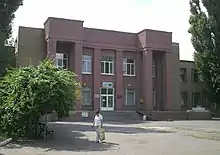
Prior to war, the principal industry of the city was in the sphere of machine building:
- The Slovvazhmash heavy-machinery production plant which produced chemical equipment for coke production and use for the businesses in Lipetsk, Kemerovo and Cherepovets. Companies in Mariupol, Kryvyi Rih, Donetsk, and Kamianske used their products.
- The Betonmash machine-building factory which produces concrete mixing plants, spare parts for mining equipment and metal works, parts for coke ovens. The factory provides foundry services for companies across Donetsk Oblast, Kharkiv Oblast, and Dnipropetrovsk Oblast.
- The Sloviansk mechanical plant which employs approximately four hundred people. It produces chemical equipment for coke production as well as overhead cranes and other machinery.
- The Artem Armature-insulator factory.
- A factory producing high-voltage insulators for hydroelectric power stations and thermal power-stations.
Before war in 2014, Sloviansk was an important health resort, providing spa treatments and mud baths using mud from the bottom of salt lakes located nearby, and attracting tourists from across Ukraine and beyond. After sustaining damage, some of the city's resort facilities were repaired, and operated up until active war broke out in Sloviansk again in 2022. As of 2023, none of Sloviank's spa resorts, or tourist facilities, are in operation.
Transport
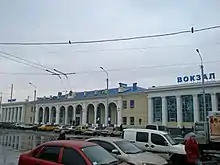
Sloviansk is a nexus of a number of railways and roads. There are three railway stations currently in use, one defunct. Three railway lines leave the city in directions of Lozova, Lyman and Kramatorsk.
Ukrainian international highway ![]() M 03 goes by the edge of Sloviansk. The national highway N-20 leaves from the city toward Mariupol, although much of this is now under Russian control. The local population is served by a trolleybus network consisting of two permanent routes and one summer route. Marshrutkas are widely used.
M 03 goes by the edge of Sloviansk. The national highway N-20 leaves from the city toward Mariupol, although much of this is now under Russian control. The local population is served by a trolleybus network consisting of two permanent routes and one summer route. Marshrutkas are widely used.
Religious organizations
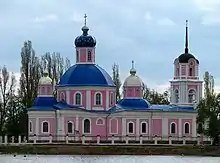
Christian churches:
- Cathedral of New Martyrs and Confessors of the Russian Orthodox Church
- Church of the Resurrection of Christ
- Church of the Andrew the Apostle
- Church of Oleksandr Nevskyi
- Church of Seraphim Sarovsky
- The "Kind New" Christian Center Church
- Church of Jesus Christ of the Protestant Church of Ukraine
Notable people
- Mykhaylo Sokolovsky, a Soviet footballer, record holder of the games played for Shakhtar Donetsk
- Maksym Marchenko, Ukrainian colonel, former governor of Odesa Oblast (March 2022 to March 2023)
Gallery
References
Notes
Sources
- CEC names winners of mayoral elections in Uzhgorod, Berdiansk, Sloviansk, Interfax-Ukraine (23 November 2020)
- Чисельність наявного населення України на 1 січня 2022 [Number of Present Population of Ukraine, as of January 1, 2022] (PDF) (in Ukrainian and English). Kyiv: State Statistics Service of Ukraine.
- "80% of the population of Slovyansk have evacuated". 7 June 2022.
- "Slavyansk: Ukraine". Geographical Names. Retrieved 15 April 2014.
- Словарь географических названий СССР [Dictionary of geographical names of the USSR] (in Russian).
- "СЛОВ'ЯНСЬК, МІСТО ДОНЕЦЬКОЇ ОБЛ". resource.history.org.ua. Retrieved 9 December 2018.
- Чисельність наявного населення України на 1 січня 2022 [Number of Present Population of Ukraine, as of January 1, 2022] (PDF) (in Ukrainian and English). Kyiv: State Statistics Service of Ukraine. Archived (PDF) from the original on 4 July 2022.
- "80% of the population of Slovyansk have evacuated".
- "'Casualties' in Ukraine gun battles". BBC News. 13 April 2014. Retrieved 9 December 2018.
- "Семнадцать километров мы шли маршем через границу". Svpressa. 11 November 2014. Archived from the original on 13 April 2022. Retrieved 18 April 2022.
- "Eight dead in Sloviansk strike as Ukrainians said to pull back in Bakhmut". Reuters. 15 April 2023. Retrieved 15 April 2012.
- Горбунов-Посадов, М.М. (2020). "БОЛЬШАЯ СОЮЗНАЯ ЭНЦИКЛОПЕДИЯ". Проектирование цифрового будущего. Научные подходы. АО "РИЦ "ТЕХНОСФЕРА": 82–87. doi:10.22184/978.5.94836.575.6.82.87. ISBN 9785948365756. S2CID 226479750.
- "Города и области Украины. Справочник по Украине". Ukrainian.SU. Archived from the original on 16 August 2014. Retrieved 12 October 2010.
- "Славянск - город Тор, курорт и воин". sotok.net. Archived from the original on 23 January 2019. Retrieved 22 January 2019.
- "Slov'yansk (Ukraine) - Encyclopædia Britannica". Britannica.com. Retrieved 21 August 2014.
- "ABANDONED SALT FACTORY «VACUUM», SLOVYANSK". Retrieved 20 October 2023.
- (in Ukrainian) 100 years ago Bakhmut and the rest of Donbass liberated, Ukrayinska Pravda (18 April 2018)
- "Yahad - in Unum".
- "Igor Girkin was one of three convicted of murder over the MH17 attack and is the elusive figure behind Vladimir Putin's war in Ukraine". ABC Australia. 19 November 2022. Retrieved 30 May 2023.
- Rachkevych, Mark (12 April 2014). "Armed pro-Russian extremists launch coordinated attacks in Donetsk Oblast, seize buildings and set up checkpoints". Kyiv Post.
- "Where to go on Independence Weekend: places where free Ukraine was being born".
- "Armed men seize police department in east Ukraine: minister". Reuters. 12 April 2014. Retrieved 12 April 2014.
- "Gunmen seize Ukraine police station in Sloviansk". BBC News. 12 April 2014. Retrieved 12 April 2014.
- "Ukraine crisis: Casualties in Sloviansk gun battles". BBC News. 13 April 2014.
- "Ukraine Army Launches 'Anti-Terror' Operation". Sky News via Yahoo! News. 13 April 2014.
- "Ukraine crisis: Rebels abandon Sloviansk stronghold". BBC News. 5 July 2014. Retrieved 25 May 2022.
- "In Ukraine's east, mayor held hostage by insurgent". Yahoo News. Associated Press. 22 April 2014. Retrieved 10 June 2023.
- "Pro-Russian mayor of Slavyansk sacked and arrested". Guardian. 12 June 2014. Retrieved 8 June 2023.
- "This article is more than 9 years old Vyacheslav Ponomarev: the 'people's mayor' who runs Slavyansk". Guardian. 25 April 2014. Retrieved 11 June 2023.
- "На Параде в Славянске выступила Штепа и Губарев" [At the Parade in Slavyansk, Shtepa and Gubarev gave sppeches] (in Russian). 9 May 2023. Retrieved 10 June 2023.
- "Ukraine rebels hold referendums in Donetsk and Luhansk". BBC News. 11 May 2014. Retrieved 10 June 2023.
- "Russia respect decision to split from Ukraine". 12 May 2014. Retrieved 10 June 2023.
- "Ukraine soldiers killed in renewed Sloviansk fighting". BBC News. 5 May 2014. Retrieved 1 June 2023.
- "Ukraine soldiers killed in renewed Sloviansk fighting". Guardian. 7 May 2014. Retrieved 3 June 2023.
- "General, 13 soldiers killed as militants down military helicopter". Russia Herald. Archived from the original on 31 May 2014. Retrieved 29 May 2014.
- "Shelling in Slaviansk". Reuters. 18 June 2014. Retrieved 6 June 2023.
- "Obama: Ukraine 'Vulnerable' To Russian 'Military Domination'". RadioFreeEurope/RadioLiberty. 11 March 2016. Retrieved 22 January 2019.
- "Ukraine President Poroshenko hails 'turning point'". BBC. Retrieved 6 July 2014.
- "Ukraine marks 7th anniversary of Kramatorsk, Sloviansk liberation". Retrieved 2 June 2023.
- "Goodbye, Lenin: how a weighty symbol of the Soviet past divided a Ukrainian city". 21 June 2015. Retrieved 2 June 2023.
- "Remembering Volodymyr Rybak: a year since the murder". EMPR: Russia - Ukraine war news, latest Ukraine updates. 18 April 2015. Retrieved 18 April 2020.
- Rob Picheta (6 April 2022). "The fight for Sloviansk may be 'the next pivotal battle' of Russia's war in Ukraine". CNN. Retrieved 11 April 2022.
- Sam Jones. "Putin declares victory in Luhansk after fall of Lysychansk". The Guardian. 4 July 2022.
- "Ukraine-Russia war: Russian forces 'taken by surprise' as Ukrainian counter-offensive advances 50km, says UK – live". the Guardian. 10 September 2022. Retrieved 10 September 2022.
- Pfaffenbach, Kai (15 April 2023). "Eleven killed in Russian strike, Ukraine rescue teams sift through wreckage". Reuters. Retrieved 15 April 2023.
- "Explainer: How important is Wagner's claimed capture of Bakhmut?". Reuters. 20 May 2023. Retrieved 31 May 2023.
- Національний склад та рідна мова населення Донецької області [Ethnic and linguistic composition of Donetsk Oblast] (in Ukrainian). Archived from the original on 8 July 2012. Retrieved 4 February 2016.
- "Climate: Sloviansk". Climate-Data.org. Retrieved 2 May 2014.
External links
- (in Russian, Ukrainian, and English) Official website
- (in Russian) Unofficial website of Slavjansk Trolleybus system
- Marble sculpture of Nicolai Shmatko

._%D0%92%D0%B8%D0%B4_%D1%96%D0%B7_%D0%B2%D1%83%D0%BB._%D0%A3%D0%BD%D1%96%D0%B2%D0%B5%D1%80%D1%81%D0%B8%D1%82%D0%B5%D1%82%D1%81%D1%8C%D0%BA%D0%BE%D1%97.jpg.webp)










